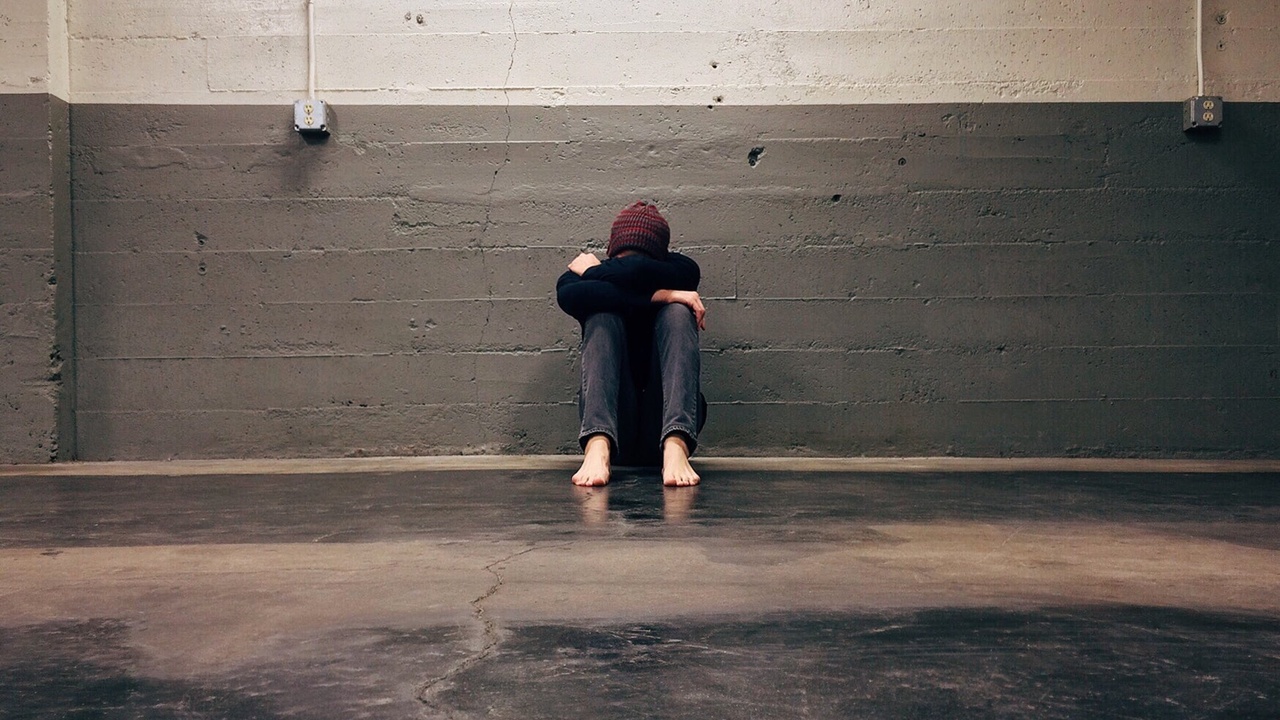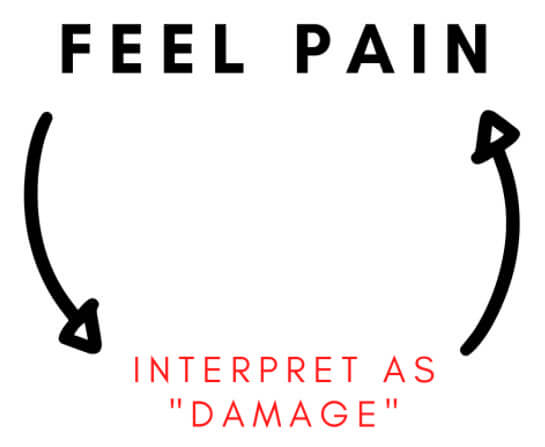How Shifting Your Perspective on Chronic Pain Can Help You Heal

When it comes to lower back, hip, and knee pain, we can get caught in a cycle of beliefs that can make our pain worse. Here's how functional training may be the way to break the cycle.
Table of Contents
- Theories About Chronic Pain and How to Treat It
- Why Rest Isn’t Always the Best Solution
- Your Perception of Pain Can Make It Worse
- Working Toward a Pain-Free, Empowered Solution to Functional Movement
- Why Functional Training Works to Treat Pain
- My Journey with Pain and Functional Training
When you’re suffering from chronic pain, you may search for the meaning behind your suffering, asking yourself What's wrong with me? Or What did I do to deserve this?
However, the meanings we ascribe to our chronic pain do not always help us get out of pain. In fact, the theories we attach to chronic pain can actually make our pain worse.
In this article, we’ll look at how your understanding of pain influences your ability to treat your pain and live your life again, without the fear of making it worse.
 It’s tough to be cheerful when your low back hurts all day.
It’s tough to be cheerful when your low back hurts all day.
Theories About Chronic Pain and How to Treat It
When I pulled my groin as a roller hockey goalie in high school, I was in a lot of pain. And I knew why. I had pulled a muscle in my groin! The muscle was hurt and injured. Doctors and physical therapists told me to rest. The theory was that because I was young, it would heal on its own.
Then when I was 16, I was in the ocean and got hit by a wave in the lower back. The pain lasted for months and months and months. I finally went to the doctor, who X-rayed me and found nothing structurally wrong. He said it would get better with rest. Again the strategy to fix my pain was rest.
In my late teens, I started suffering from severe pain, numbness, and tingling in my hands and wrists. Doctors told me that I didn’t have carpal tunnel syndrome. They said I had simply just overused my hands and wrists. That was the meaning of the pain: overuse. The fix? Just rest my hands and wrists (i.e. no more using the computer).
Later, in my 20s, when my feet and knees started hurting, doctors told me I was just getting older, that I needed to rest more so that I didn’t wear down my joints. Once again, rest was the fix for my pain.
In all these examples, you can see how the interpretation of the pain determined a specific healing strategy. That’s where chronic pain sufferers like you and I can get trapped. Just because the diagnosis you are given for your pain makes logical sense, it doesn’t mean the prescribed strategy works.
Why Rest Isn’t Always the Best Solution
In all the cases above, rest wasn’t a terrible suggestion for my aches and pains, at least not in the beginning, but it also wasn’t the most effective solution.
Rest can give you time to step back and assess what’s going on. In fact, whenever I work with a client with chronic pain who does Crossfit or similar high-intensity exercise classes, I often suggest backing off for a bit so we can see if the class is making their shoulder hurt or hip ache.
You can’t tell unless you have at least a week off.
But my team and I, and our clients, have found that resting can also be a terrible option for treating chronic pain, especially in the long run.
In functional training, we’re always thinking about how to find solutions for pain through movement and muscle strength and balance, rather than through the more conventional, and often less effective, protocols for rest, ice, injections, pills, and surgery (what I call RIIPS).
Doctors have also found that rest can be counterproductive, and that’s why they have dramatically changed their tune on back pain over the last few decades. They used to say, “Rest until the pain goes away. If it keeps hurting, get an X-ray or MRI so we can see what’s wrong. If your back hurts chronically, something is damaged that we need to fix surgically." Now they say, “Keep moving, and don’t get an X-ray or MRI unless there are signs of something serious like cancer or severe nerve impingement.”
The perception of back pain fundamentally changed from a sign that you may be severely damaged and need surgery to much less severe signals of muscle dysfunction that can often be solved with simple movement.
See also: Can You Trust an MRI for Back Pain?
Your Perception of Pain Can Make It Worse
What most people don’t realize is that the perceived cause of your pain influences more than just your strategy to fix it. Your perception also influences how severe your experience of pain is.
Put another way, if you think your pain is because something is severely damaged, you’ll feel the pain more severely. You’ll guard more. You’ll be more on edge and anxious because you’re afraid of doing further damage.
There’s some interesting brain wiring that makes this happen, and it’s been demonstrated in experiments with real-live humans like you and me.
Basically, if you think you’re about to be hurt badly, whatever happens next is likely to hurt a whole lot worse. Pain is a trained response to protect us from perceived danger and risk. But it does not always correlate to real damage or harm.
Check out this TedX talk from neuroscientist Lorimer Moseley for more on the science behind the intensity of pain.
So, if you think your knee hurts because it’s degenerating and grinding away due to advanced osteoarthritis, that knee pain is likely to feel a whole lot worse.
If you think your back pain is due to arthritis that you saw in an X-ray, whenever your back feels even a twinge, you’ll think you're doing even more damage, so you’ll tense up, lock everything down, and stop moving your spine. And every little jolt will feel like you’re being electrocuted.
And if you think your hip pain is because you’ve got torn up labral bits and bone shapes that are causing premature rubbing, you’ll interpret every twinge as a sign of your hip breaking, and the pain will get louder and louder, as the muscles around the hip get weaker and weaker.
You’ll get trapped in a pain cycle. You’ll correlate feeling pain with damage. This makes you feel the pain more, which makes you guard that "badly damaged" body part more, which makes you feel even MORE pain…

The belief that pain always means damage puts you in a pain cycle.
The takeaway here is simple: These explanations for chronic pain are based on fantasy and not scientific fact. And they infect you with counter-productive fears.
See also: Fixing Chronic Pain Flare-Ups When Fixing Dysfunctional Muscles
BUT I DEFINITELY HAVE ARTHRITIS!
Many people with back, knee, and hip pain have been told that their pain is from arthritis. The evidence of arthritis can be easily and plainly seen in X-rays, after all. I have been told I have hip arthritis (and a spondylolisthesis, if you really must know).
There’s the damaged bone! No cartilage! It's plain to see on the X-ray! That’s your explanation.
Full stop.
What you might not hear is that research consistently shows that the severity of arthritis in an X-ray has NO LINK AT ALL to the experience of pain.
Put another way, you can show bone-on-bone arthritis in an X-ray and have absolutely zero symptoms.
This is a consistent phenomenon with all kinds of allegedly iron-clad orthopedic theories about back pain, rotator cuff tears, and knee and hip arthritis published in respected scientific journals.
Understanding Arthritis
The conventional orthopedic story is simple: Your bones are degenerating as they rub against each other, and this causes pain. You can verify this in an x-ray. However, research consistently shows that the severity of arthritis in an x-ray has no link at all to the experience of pain.
Put another way, you can show bone-on-bone, grade four osteoarthritis in an x-ray, and have no symptoms. The same is true for cartilage damage, labral tears, and tendon damage–x-rays that show damage can’t be linked directly to the experience of pain. Research shows that you can have no signs of arthritis in an x-ray and still have symptoms of pain and immobility. You can have a lot of "arthritis" and have no complaints at all!
Even if you have terrible, awful, grade four osteoarthritis in an x-ray, you may actually experience ZERO symptoms. And on the opposite side of the same coin, you can have zero signs of arthritis in an x-ray, and still have symptoms of pain and immobility.
Researchers have done multiple studies on knee osteoarthritis in thousands of people and found that there is no link between the severity of arthritis shown on an x-ray and actual knee pain.
And, again, a significant percentage of people with completely asymptomatic, pain-free knees show signs of knee osteoarthritis on x-rays. The numbers are actually huge.
For example, a 2017 study published in the British Journal of Sports Medicine found that in asymptomatic adults under 40, 4 percent to 14 percent show signs of knee osteoarthritis. In the over 40 population, 19 percent to 43 percent show signs of knee osteoarthritis.
The point is: "arthritis" is not a good explanation for why your body hurts.
Working Toward a Pain-Free, Empowered Solution to Functional Movement
When you’re suffering from chronic pain, you may have arthritis, a torn labrum or meniscus or rotator cuff, tendinitis, bursitis, some kind of chrondral lesion, or more… The list can go on and on.
You may get the X-rays, MRIs, or CT scans to "prove" it.
Or you may have fibromyalgia or another diagnosis from a growing list of muscle and limb “disorders.”
The question to ask yourself is this: How does my diagnosis affect how I treat my pain?
Almost without exception, the strategy that comes with these medical explanations for chronic pain is first REST, then eventually something invasive (like arthroscopic surgery or anesthetic injections or some fancy new kind of injection with little evidence to back it).
Are those productive strategies? No.
Those strategies and their meanings suggest that you are so broken that you no longer have any power to help yourself. They suggest that you have such severe damage that nothing short of the miracle of modern medical technology can end your pain.
You are out of the driver's seat. You can do nothing. You have no more responsibility. You have no say in the way this goes anymore. And that’s disempowering, making you fear movement, and contributing to the belief that any bit of pain is a sign of further damage.
This is what traps you in a cycle of pain that can make your pain worse and worse and worse.
The traditional approach, with rest and invasive surgery, is also an incredibly big gamble. If a surgery doesn't work, does it mean the surgeon wasn't good? Does it mean you are even more damaged than you previously thought? That's a common story for those who have undergone unsuccessful back surgeries.
But what if you choose something less invasive? What if you do some massage, acupuncture, electrical stimulation, or some other modality that doesn't work? Does that mean you need a STRONGER intervention? Or maybe your practitioner doesn't know how to massage you or needle you the right way?
Those are certainly possibilities, but they also make you blind to the role YOU need to play in getting your body moving again.

Functional training builds your abilities and reduces chronic pain.
Why Functional Training Works to Treat Pain
I encourage anyone battling chronic pain to take this first brave step: choose a better perspective on your pain.
The one I believe is most helpful and productive is, My pain is telling me I’m not training my body properly.
It’s a simple meaning for your pain that encompasses many scenarios and gives you the power to make great change.
Ways Pain Tells You You’re Not Training Properly
- Hip pain: If you sit on your butt for 17 out of your 18 waking hours, you’re under-training numerous muscles around your hip joint (and neglecting so many different motions your hips should be able to achieve). Time to make a change.
- Knee pain: If you run 300 miles a week and never stretch, massage, or otherwise relax your leg muscles, you’re overtraining your foot, ankle, calf, thigh, and hip muscles in an extremely repetitive pattern. Time to make a change.
- Shoulder pain: If you curl your body over your laptop and mobile phone for 10 hours a day, you’re under-training muscles that allow for proper spine, shoulder blade, and arm positioning. Time to make a change.
- Foot pain: If you wear stiff, thick shoes all day long and haven't let your foot, ankle, or calf muscles do any real work in decades, you are limiting your range of motion. (Would you expect your arm to feel good if you encased it in a cast for the rest of your life?) Time to make a change.
From this perspective, pain is not a sign of damage. It’s not a sign of a malfunctioning body. It’s a sign that you need to make a change to the way you move and use your body.
Katy Bowman talks more about this in her book Move Your DNA: Restore Your Health Through Natural Movement.
This is not a short-term, quick fix. You can’t pay someone to fix it for you. The process can take months, even years, to retrain your body.
But it’s the least invasive, cheapest, and most rewarding, productive, and empowering strategy we’ve found.
Whenever we work with someone who has had pain for a long time or a severe amount of pain somewhere in their body, they start to think that this means their pain cannot be solved without drastic intervention.
This belief gets reinforced when your aches and pains don't go away in the time frame that you want, and you start to think, This must mean my hip or shoulder is really messed up.
That puts you right back in the mindset that can increase your pain and make you feel helpless and hopeless.
The reality is simple. If you want to be able to move more without pain, you need to practice moving more. You may need to learn some new things and move in new ways, but staying still will never improve your ability to function in daily life. Lying in bed only makes you better at lying in bed. Sitting on your butt only makes you better at sitting on your butt.
To get better, you must train your body to move more and in a variety of new ways. This makes you resilient.
See also: How Do You Relax Tight Muscles?
My Journey with Pain and Functional Training
In my journey with pain, I went from feeling constantly fatigued, lethargic, achy, limited, victimized, and frustrated to feeling confident, powerful, and hopeful once I started telling myself that my body simply needed to be retrained.
I went from being unable to walk down stairs without pain in my 20s, to working on complex movement tricks in my late 30s.
I went from constant pain and tingling in my hands to writing articles like this.
These days, I get frustrated trying to learn physically challenging movements and positions, but I no longer feel frustrated that my body is breaking down before its time. I get annoyed that my growing son has more energy reserves than I do, but I rest with a smile knowing that I can show him how to move right and feel right for the long-term.
My chronic pain is not destroying my life. And it's not destroying the lives of my family members.
This is only possible because I chose a perspective on my pain that led me to a productive strategy for dealing with it. I saw that every other meaning led to the same conclusion: "You’re broken and done for".
I chose to believe that there was something I could do to help myself. And over time, I did.
This same perspective has helped thousands help themselves. And I hope it helps you, wherever you are on your journey out of chronic pain.
To effectively navigate your way out of pain, be sure you understand the fundamentals of muscle imbalances and dysfunctions and the strategies to fix muscle imbalances.
Before you agree to invasive orthopedic surgery, consider the alternatives.

